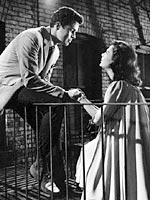

Who gets to tell whose story, and in what language? Is a musical about interracial violence conceived and created by four white men (Sondheim, Bernstein, the original show’s librettist Arthur Laurents, and its director and choreographer Jerome Robbins) really best reinterpreted for the 21 st century by more white men (Spielberg, screenwriter Tony Kushner, choreographer Justin Peck)? Taking on these debates in a productive way, one that doesn’t just restage the same old critical battles like the Jets and the Sharks’ endless turf wars, requires some consideration of the property’s long and, from its inception, troubled history.

Rumble (Molto allegro) – Climactic gang battle during which the two gangleaders are killed.įinale (Adagio) – Love music developing into a procession, which recalls, in tragic reality, the vision of “Somewhere.But the loss of the songwriter who would go on to invent a new kind of musical theater, and the resulting conversations about the history of the form we’ve been having over the last week, also place a variety of preexisting questions in a new light: questions about what it means to adapt West Side Story in 2021, 60 years after Robert Wise’s Oscar-winning film adaptation and 64 since the play’s Broadway debut. “Cool” Fugue (Allegretto) – An elaborate dance sequence in which the Jets practice controlling their hostility. Meeting Scene (Meno mosso) – Music accompanies their first spoken words. Mambo (Presto) – Reality again competitive dance between the gangs.Ĭha-cha (Andantino con grazia) – The star-crossed lovers see each other for the first time and dance together. Scherzo (Vivace leggiero) – In the same dream, they break through the city walls and suddenly find themselves in a world of space, air, and sun. “Somewhere” (Adagio) – In a visionary dance sequence, the two gangs are united in friendship. Prologue (Allegro moderato) – The growing rivalry between two teenage street gangs, the Jets and Sharks. The printed score includes the following description: We hear first the rivalry between the Jets and the Sharks, then the utopian opposite their juxtaposition creates a dramatic tension that shapes the entire work. More deeply, they tilt the narrative weight from a love story to gang confict. Bernstein and his orchestrators use vibrant instrumental combinations and a huge percussion section (not to mention the vocal talents of the orchestra members!) to enhance the kinetic quality of the rhythms. The crucial role of dance in West Side Story added to the challenge of adapting the music for the concert platform. These dances are the product of many different orchestrators with a thorough editing job by the composer.” Most prominent among these was Sid Ramin, to whom Bernstein dedicated the work. As Skitch Henderson described, “By the time MGM got around to doing the picture, everybody had a hand in arranging or, should I say, re-arranging the original stage version. Plans were quickly made for a film version of the musical, which in turn was adapted for these Symphonic Dances. Bernstein’s deep empathy for the universal human element in any particular musical style (it is what made him so effective a teacher) found no better outlet the historically specific musical clichés in West Side Story only throw the classic nature of its plot and characters into greater relief. I heard rhythms and pulses and – most of all – I can sort of feel the form.” West Side Story’s “rhythms and pulses” toss together everything from Tin Pan Alley to cool jazz to Latin dances in an eclectic postwar urban soundscape. Their collaboration with Stephen Sondheim and Jerome Robbins took shape quickly, as Bernstein recorded in his diary: “Suddenly it all springs to life.
#West side story composer full
After all, as Leonard Bernstein recalled: “In New York we had the Puerto Ricans, and at that time the papers were full of stories about juvenile delinquents and gangs.” The story goes, though, that Bernstein and playwright Arthur Laurents had been toying with a Catholic/Jewish scenario until a chance meeting in southern California and a Los Angeles Times headline about gang violence between Mexicans and whites suddenly convinced them that this hot-button issue had greater creative potential. Transplanting the feud between Shakespeare’s Montagues and Capulets to rival Puerto Rican and white gangs in New York may seem obvious in hindsight.


 0 kommentar(er)
0 kommentar(er)
